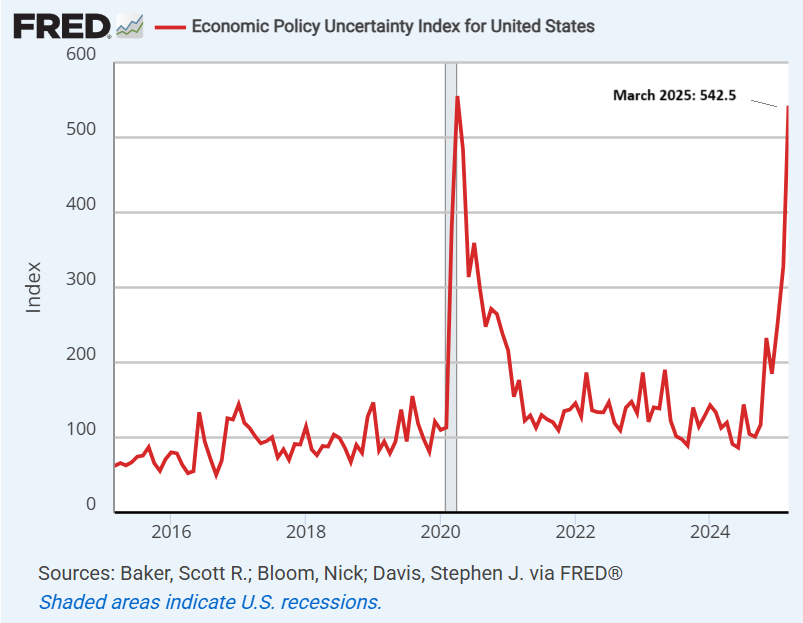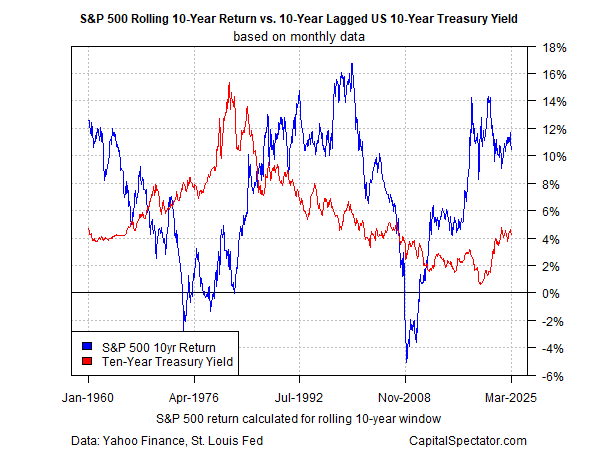Measuring shifts in uncertainty is a slippery beast, but it’s easier to intuit when big changes unfold vs. the recent past. We’re knee-deep in one of those moments. One of the tell-tale signs is that the US stock market is demanding a higher risk premium to compensate for the spike in uncertainty, a.k.a. prices are falling, which translates to a higher expected return for some forward time horizon.
One attempt to quantify uncertainty is found in the Economic Policy Uncertainty Index, a news-based indicator developed by a trio of professors.
According to this measure, uncertainty for the US has spiked through March 2025 to the highest level since the pandemic was raging in April 2020.
Tariff risk is driving the uncertainty. Unsure about how the Trump administration’s sharp policy pivot will affect economic activity, the market is reacting rationally to a hefty dose of elevated doubt and ambiguity by reducing prices until/if the results suggest a better-than-expected outcome relative to the mostly negative forecasts to date.
“Tariff risk has been well telegraphed and is largely priced in corners of the market. So liberation day may not be a complete shocker. However, no one wins from trade war, and clouds are gathering over the global growth outlook,” Barclays (LON:BARC) equity strategist Emmanuel Cau wrote in a Friday note. “Negotiations will likely start after April 2, which leads to an extended period of uncertainty about the final scope, level and timing of tariffs.”
The market’s expected return moves inversely to prices, and so the ongoing slide in the S&P 500 Index equates with higher performance over some unknown forward time window.
The future’s uncertain, but the past is always clear, and so it’s useful to consider how stocks have performed over some historical period that reduces noise relative to a “risk-free” benchmark. Let’s use the US 10-year yield as a proxy for a “safe” asset. Buying and holding a 10-year Note assures earning something close to the current yield if the security is held through maturity.
For comparison, the chart below plots the rolling 10-year annualized return for the S&P 500 Index against the current 10-year yield. (S&P 500 and 10-year yield data for March 2025 are as of Mar. 28).
The main takeaway: for a number of years, US equities have outperformed the current 10-year yield by a wide and arguably unsustainable margin. We’ve been here before, which led to the market correcting in the extreme. The search for equilibrium is a volatile affair, in good times and bad, and so the market tends to overreact on both sides of what might be considered fair value.
How much does the stock market need to correct to reflect a reasonable estimate of the recent rise of macro uncertainty? Unclear, but the chart above suggests there’s still plenty of room for a higher expected equity risk premium, a.k.a. lower prices.
Stepping back and reviewing the long history of equity prices suggests that a degree of mean reversion prevails, eventually. Translating this view into looking ahead implies that expected returns fluctuate and so risk premiums, like everything else, also vary, largely in line with changing expectations about the economy. Investors demand higher — perhaps much higher — compensation during times of economic stress vs. those periods when all seems right with the world.
Expectations of the future are always in a state of flux, even if there are times when stability appears prevalent and permanent. We’re coming out of one of those periods of relative calm and assumptions that the future is relatively clear and entering into a stretch of heightened uncertainty.
The stock market, unsurprisingly, is struggling to price in the sudden arrival of a new world order. In time, a degree of equilibrium will arrive. But for the moment, the discounting machine, otherwise known as the stock market, is spinning its wheels at an accelerated pace in an effort to find a discounting rate that appears to make sense in the new regime that’s unfolding.
How long will this take? No one knows, but it’s a reasonable bet that it will take longer than the average investor assumes.
